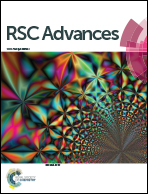Facile synthesis of shell–core polyaniline/SrFe12O19 composites and magnetic properties
Abstract
Polyaniline (PANI)/SrFe12O19 (SrM) composites were synthesized by in situ polymerization and characterized by XRD, FT-IR, SEM, TEM and VSM. The results showed that SrFe12O19 particles obtained by a hydrothermal method were of uniform hexagonal plate-like structures with diameters ranging from 2–5 μm. PANI/SrM composites with 15 wt% PANI displayed a shell–core structure. The SrFe12O19 particles were embedded in PANI. Magnetic property results showed that, due to the presence of a nonmagnetic PANI layer, the values of Ms, Mr, Hc were all lower than those of the pure SrFe12O19 particle, and indicated the information of a “shell–core” structure composite.



 Please wait while we load your content...
Please wait while we load your content...